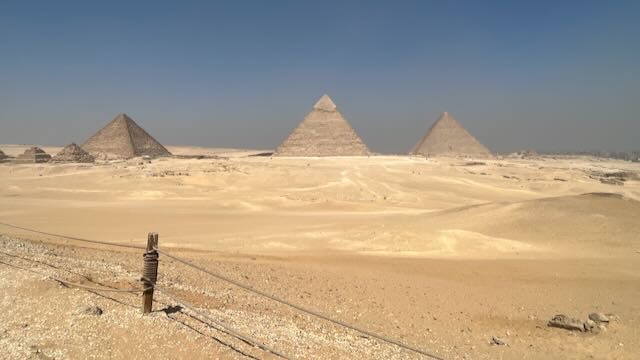
If you had told me as a kid that one day I’d be standing at the base of the Great Pyramids of Egypt, I’d have said you were crazy. But there we were last week, in the eastern part of the Sahara Desert, looking up at remarkable structures built five thousand years ago.
Our guide told us the stories behind their construction and convinced us not to bother going inside because the tombs are quite difficult to get to through small spaces. With my claustrophobia, that sounded like a bad idea. Besides, he said, there are no artifacts there because they were raided centuries ago, so all we’d see would be blank walls.
Later in the trip, we did get to visit tombs in the Valley Of The Kings and Valley Of The Queens, where Ramses II, Nefertari, and other Egyptian royals had been buried. There are plenty of hieroglyphs and brightly painted images on the walls, but it’s a long way down and back up. Too bad the ancient Egyptians didn’t invent escalators. The daytime outdoor temperatures while we were there averaged 113, even higher in the tombs, so just making the round trip was a lesson in how much humans can sweat. Interesting fact: when it’s that hot, the time it takes to turn a refreshing bottle of cold water into soup is 11 minutes, at which point it has lost its ability to invigorate.
After checking out three or four rather impressive tombs, they started to look — and feel — the same. Besides, we eventually went to the Egyptian Museum in Cairo to see more artifacts from the tombs, including the treasures of Tutankhamen.
Over the course of ten days, we had lots of remarkable experiences like that, including being mere feet away from The Sphinx, standing atop the Aswan Dam, and visiting lots of temples from long-dead civilizations. As lifelong atheists, wherever we travel, Martha and I don’t go into churches, mosques, or temples. Yet we had no problem hearing about ancient Egyptian mythology, despite it being full of just as much nonsense as its modern-day counterparts — gods and goddesses depicted as animals, mummification, rituals to prepare humans for the afterlife, etc.
It was fascinating to hear about all of it, although I can’t remember much — other than one story about a multitude of people who followed a crocodile god. For some reason, that seemed very current to me. One of my favorite moments was when we learned the ancient Egyptians had a deity named Ptah, who Martha pronounced The God Of The Spit Take.
Other sites we visited included the Unfinished Obelisk (because even things that weren’t things in ancient Egypt were still things), the Step Pyramid in Saqqara, the Bent Pyramid in Dahshur, and the Temple of Philae. I’m pretty sure we saw more temples on this trip than I did the year all my friends in junior high turned 13.
We also had the unique thrill of taking a dip in a swimming pool on the top deck of a riverboat as it cruised up the Nile River, a moment I could barely wrap my head around. I had been worried about this part of the trip because I have long had problems with seasickness. In fact, I asked my doctor to prescribe a medication a friend who suffers similarly took when she went scuba diving in Fiji and reported no issues. He told me it was very unlikely I’d get nauseous on a river, but he wrote the scrip nonetheless. Fortunately, I never had to pop those pills because I barely felt the motion.
However, Martha and I both had problems with what I called Ramses’ Revenge. I won’t go into the details, but suffice to say there was severe gastric distress for a couple of days. It turned out the tap water in Egypt is about as safe for Americans as it is in Mexico, which is to say not at all. We stuck to bottled water and avoided salads and fruit from then on.
Last thing to add on that subject: there are few things quite as distressing as going into a public bathroom — which you’ve paid to enter — only to find no toilet paper in any of the stalls. We were surprised to encounter this complication at several of the iconic tourism sites. You’d think after 5,000 years, someone would have solved that disgusting problem. Instead, many of those places were about as hygienic as a porta-potty at Burning Man.
I have quite a few more notes from this trip which I’ll share with you next week.
